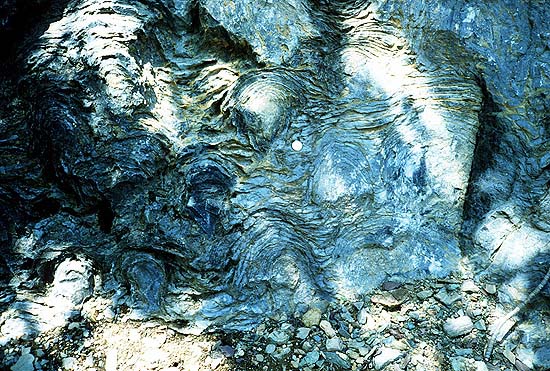As much as we know about life on planet Earth, how it actually got here in the first place is still the subject of much investigation. Organic molecules probably first made it to Earth encased in meteorites – but the mystery lies in how conditions on an early Earth that made the developments of life in its most basic form possible.
Now researchers at NASA Ames studying abiogenesis – the chemical origin of life, have successfully managed to reproduce the compounds uracil, cytosine, and thymine, which make up three key components of our genetic material, in a laboratory. They found that a sample of ice containing pyrimidine, exposed to ultraviolet wavelengths – in a simulation of conditions in outer space are able to produce these basic building blocks of life.
It was originally believed that the first life originated in a warm pond – a primordial soup of sorts which the 1952 Urey-Miller experiment sought to recreate by passing an electrical discharge through a mixture of water, methane, ammonia, and hydrogen. Later, it was believed that mud was the medium that allowed life to begin, and experiments since Urey-Miller were successful in producing uracil and cytosine together – two key components of RNA, the polymer used to read DNA codes and synthesize proteins for life processes. RNA is the main ingredient of retroviruses, which replicate despite being non-living matter. Now, scientists have managed to replicate the basic structure for all three components of RNA with the ring-shaped molecule of Pyrimidine, a compound of carbon and nitrogen.
“We have demonstrated for the first time that we can make uracil, cytosine, and thymine, all three components of RNA and DNA, non-biologically in a laboratory under conditions found in space,” said researcher Michel Nuevo at NASA’s Ames Research Center in Moffett Field, California. “We are showing that these laboratory processes, which simulate conditions in outer space, can make several fundamental building blocks used by living organisms on Earth.”
In order to synthesize these compoinds, the researchers placed an ice sample onto a cold (approximately –440 degrees Fahrenheit) substrate in a chamber. The block of ice is then irradiated by high-energy ultraviolet (UV) photons exuded from a nearby hydrogen lamp. These photons break apart the ice’s chemical bonds, reducing the ice’s molecules to fragments which then recombine with each other and begin forming new compounds – among them are uracil, cytosine, and thymine.
For years, NASA Ames’ team of researchers have worked to recreate the environments within interstellar space and our own outer Solar System. Of particular interest in recent years was their discovery of a class of carbon-rich compounds, known as polycyclic aromatic hydrocarbons (PAHs), that are found in meteorites. These contain the most abundant carbon-rich compound seen throughout the universe. PAHs are usually structures containing several six-carbon rings bonded together in hexagon shapes, like honeycombs or a pattern of chicken wire.
The molecule pyrimidine has also been found in meteorites, but its exact origin remains unknown. Like the carbon heavy PAHs, pyrimidine may be created by the last bursts of energy given off by red giants when they die, or perhaps they bond together when caught in heavy clouds of interstellar dust and gasses.
“Molecules like pyrimidine have nitrogen atoms in their ring structures, which makes them somewhat wimpy. As a less stable molecule, it is more susceptible to destruction by radiation, compared to its counterparts that don’t have nitrogen,” said Scott Sandford, one of the space science researchers at Ames. “We wanted to test whether pyrimidine can survive in space, and whether it can undergo reactions that turn it into more complicated organic species, such as the nucleobases uracil, cytosine, and thymine.”
In their hypothesis, these researchers suspected that were the molecules of pyrimidine able to survive long enough, they would be able to migrate into the interstellar dust clouds. Once inside these dense clouds, they could then protect themselves against any of the harmful radiation from space. Hidden inside the clouds, they would mostly freeze into grains of dust.
They then tested this at the Ames Astrochemistry Laboratory. Their experiment revealed that freezing pyrimidine is in an ice primarily consisting of water, but also in cases where they ice contains traces of ammonia, methanol, or methane, the honeycomb molecules are much more protected against destruction by radiation than if they happened to be floating through space in a gaseous phase. Rather than being destroyed, these molecules began to take on new forms once frozen.
“We are trying to address the mechanisms in space that are forming these molecules. Considering what we produced in the laboratory, the chemistry of ice exposed to ultraviolet radiation may be an important linking step between what goes on in space and what fell to Earth early in its development,” said Christopher Materese, another researcher at NASA Ames who had been studying the properties of PAH’s.
“Nobody really understands how life got started on Earth. Our experiments suggest that once the Earth formed, many of the building blocks of life were likely present from the beginning. Since we are simulating universal astrophysical conditions, the same is likely wherever planets are formed,” says Sandford.
Perhaps a great deal of the research may further reveal that life in some form is an inevitable chemical occurrence.
|
James Sullivan
James Sullivan is the assistant editor of Brain World Magazine and a contributor to Truth Is Cool and OMNI Reboot. He can usually be found on TVTropes or RationalWiki when not exploiting life and science stories for another blog article. |

